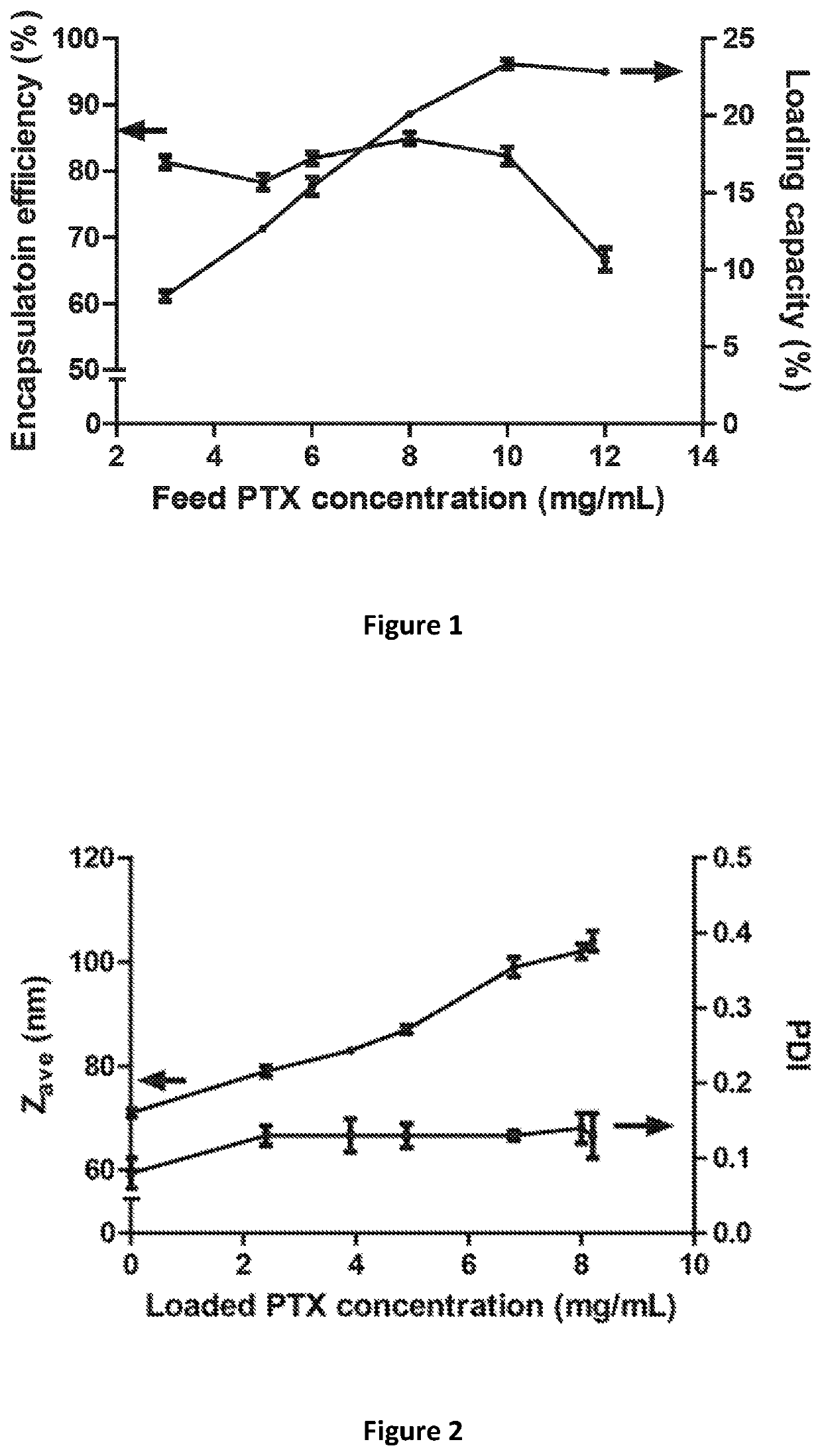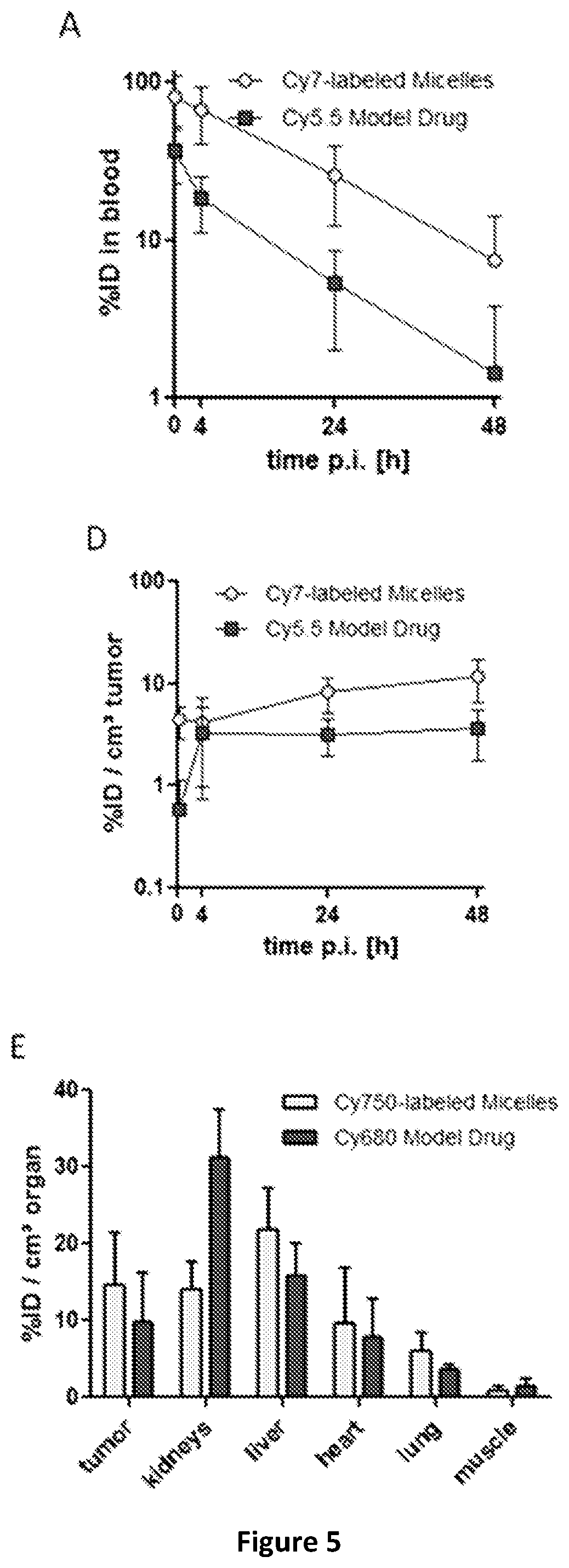Amphiphilic block copolymers for delivery of active agents
a technology of amphiphilic block and active agent, which is applied in the direction of heterocyclic compound active ingredients, organic active ingredients, drug compositions, etc., can solve the problems of insufficient stability in vivo, limit the applicability of a new polymer platform technology, and insufficient concentration of drugs at the aimed site of action
- Summary
- Abstract
- Description
- Claims
- Application Information
AI Technical Summary
Benefits of technology
Problems solved by technology
Method used
Image
Examples
example 1
Copolymer Synthesis
[0057]Copolymer poly(ethylene glycol)-b-(N-(2-benzoyloxypropyl) methacrylamide)) (mPEG-b-p(HPMAm-Bz)) was synthesized using mPEG2-ABCPA as macroinitiator and HPMAm-Bz as monomer. The monomer has been synthesized following the procedure described in Y. Shi et al., Biomacromolecules 2013, 14, 1826-1837. The phenyl group is attached through an ester linker to the HPMA monomer. The macroinitiator synthesis is described in D. Neradovic et al., Macromolecules, 2001, 34 (22), pp 7589-7591).
[0058]The monomer was dissolved at a concentration of 0.3 g / mL in acetonitrile (dried on A4 molecular sieves) and the molar ratio of monomer-to-macroinitiator was 200 / 1. The solution was degassed by flushing with nitrogen for 30 minutes. The reaction was conducted at 70° C. for 24 hours under a nitrogen atmosphere. The polymer was purified by precipitation in diethyl ether and this dissolution / precipitation procedure was repeated twice. The polymer was dried under vacuum at room temper...
example 2 preparation
of Micelles
[0061]Empty mPEG-b-p(HPMAm-Bz) micelles were prepared as follows. mPEG-b-p(HPMAm-Bz) was dissolved in THF at a concentration of 27 mg / mL and subsequently, 1 mL of the polymer solution was added dropwise to 1 mL of reverse osmosis (RO) water while stirring. The mixture was incubated at room temperature for 48 hours to allow evaporation of THF. The resulting micellar dispersion was filtered through 0.45 μm nylon membrane (Acrodisc®).
[0062]Paclitaxel (PTX)-loaded micelles were prepared as follows. PTX and mPEG-b-p(HPMAm-Bz) (structure shown in FIG. 10) were dissolved in THF with PTX concentration ranging from 3 to 12 mg / mL and 27 mg / mL for the polymer. 1 mL of the polymer solution was added dropwise to 1 mL of reverse osmosis (RO) water while stirring. The mixture was incubated at room temperature for 48 hours to allow evaporation of THF. The resulting micellar dispersion was filtered through 0.45 μm nylon membrane (Acrodisc®).
[0063]The measuring of the loading capacity, enc...
example 3
In Vivo Studies
[0067]Human A431 tumor Xenografts were established by subcutaneous inoculation of the mice in the right flank with 1×106 A431 cells suspended in 100 μL PBS pH 7.4. Tumors were measured using a digital caliper. The tumor volume V in mm3 was calculated using the formula V=(π / 6)LS2 where L is the largest and S is the smallest superficial diameter. When the tumors reached a volume of 80-100 mm3, mice were included in the study. The mice were injected with 100 μL of the PTX-loaded micelles (3.2 mg / mL PTX and 27 mg / mL polymer) via the tail vein.
[0068]Plasma concentrations of PTX after i.v. injections of different PTX formulations in A431 human tumor-bearing female Crl:NU-Foxnu1nu mice (22.5±2.5 g) mice (n=7-8) were measured in time.
[0069]The four formulations included PTX loaded micelles of the invention mPEG-b-p(HPMAm-Bz) obtained according to Example 2 and three comparative formulations, being PTX loaded in thermosensitive micelles mPEG-b-p(HPMAm-Bz30-co-HPMAm-Lac70) and ...
PUM
| Property | Measurement | Unit |
|---|---|---|
| temperature | aaaaa | aaaaa |
| pH | aaaaa | aaaaa |
| half-time | aaaaa | aaaaa |
Abstract
Description
Claims
Application Information
 Login to View More
Login to View More - R&D
- Intellectual Property
- Life Sciences
- Materials
- Tech Scout
- Unparalleled Data Quality
- Higher Quality Content
- 60% Fewer Hallucinations
Browse by: Latest US Patents, China's latest patents, Technical Efficacy Thesaurus, Application Domain, Technology Topic, Popular Technical Reports.
© 2025 PatSnap. All rights reserved.Legal|Privacy policy|Modern Slavery Act Transparency Statement|Sitemap|About US| Contact US: help@patsnap.com



